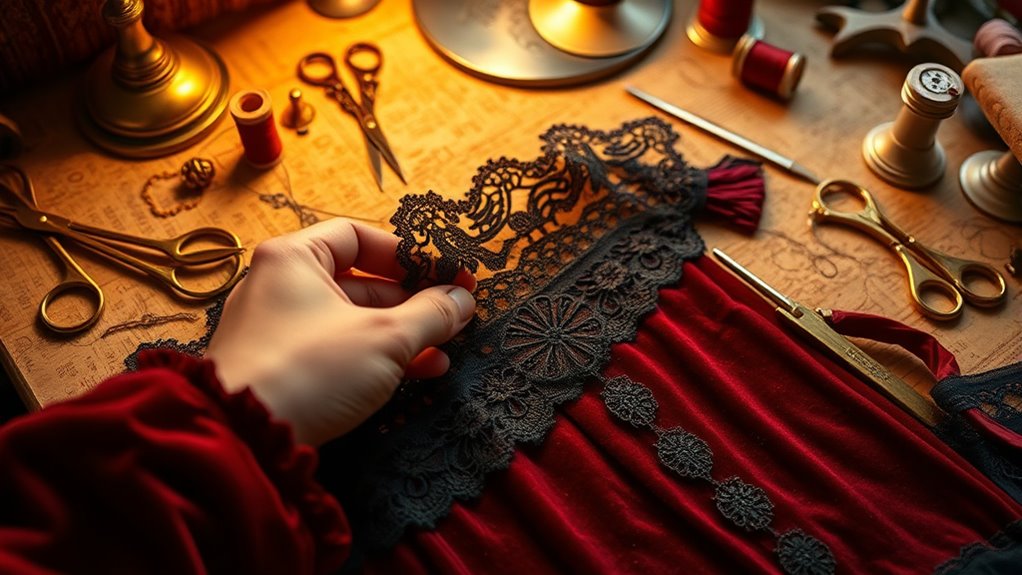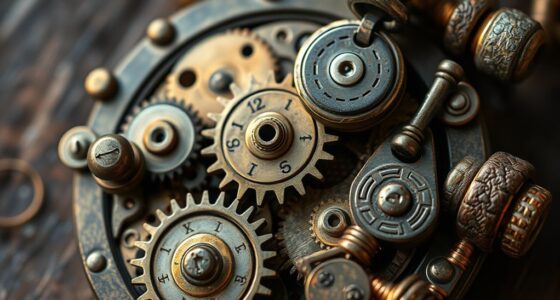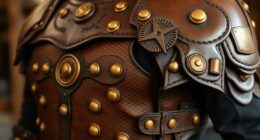To sew neo-Victorian fashion with DIY tailoring hacks, focus on precise darting and princess seams to shape your garments authentically. Use hand-stitching for delicate finishes and incorporate embellishments like lace, ruffles, and buttons thoughtfully to enhance vintage charm. Choose fabrics like velvet or brocade for structure, and consider adding padding or interfacing for extra body. Master these techniques, and you’ll create stunning, vintage-inspired pieces that reflect true Victorian elegance—all while exploring more tips ahead.
Key Takeaways
- Use vintage patterns as a base and modify details like puffed sleeves or high collars for authentic Neo-Victorian style.
- Incorporate Victorian-inspired embellishments such as lace trims, buttons, and embroidery to elevate simple fabrics.
- Practice precise darting, princess seams, and hand-stitching techniques to achieve authentic tailoring and fit.
- Select fabrics like velvet, brocade, or heavy cotton, and coordinate embellishments to ensure cohesive, luxurious garments.
- Combine traditional sewing methods with creative design to craft unique, vintage-inspired pieces reflecting Victorian elegance.

Have you ever wondered how to bring Victorian elegance into modern fashion? If so, you’re in the right place. Embracing Neo-Victorian style means blending historical details with your personal flair, and that starts with understanding Victorian embellishments and tailoring techniques. These elements can elevate any garment, turning simple pieces into stunning, vintage-inspired creations. The key lies in mastering a few foundational skills that allow you to incorporate intricate Victorian details into your sewing projects.
Victorian embellishments are the heart of this aesthetic. Think lace trims, ruffles, pleats, and decorative buttons—each adding a layer of sophistication and charm. You don’t need to overdo it; selective placement of embellishments can make a subtle yet impactful difference. For example, adding lace cuffs or a ruffled collar instantly transforms an ordinary blouse into a Victorian-inspired piece. Embellishments also extend to embroidery and beading, which can be sewn onto cuffs, bodices, or skirts for a luxurious touch. The trick is to choose embellishments that complement your fabric and overall design, ensuring they enhance rather than overpower your look.
Victorian embellishments like lace, ruffles, and buttons add charm without overwhelming your design.
Getting the tailoring techniques right is equally important. Victorian fashion often featured fitted bodices, corset-like structures, and detailed seams. You can emulate this by practicing precise darting and princess seams, shaping your garment to your body’s curves. Using techniques like hand-stitching for delicate seams or adding interfacing to maintain structure helps achieve that authentic Victorian silhouette. When working with heavier fabrics such as brocade or velvet, consider techniques like pad-stitching and underlining to achieve a smooth, polished finish. These skills might seem complex at first, but with patience and careful practice, you’ll find that tailoring your own garments becomes more intuitive. Additionally, understanding specialized sewing techniques can greatly improve the authenticity and quality of your Neo-Victorian creations.
Another valuable tip is to use historical patterns as a base, then modify them to suit your style. This allows you to focus on perfecting your tailoring techniques and Victorian embellishments without starting from scratch. Adding elements like puffed sleeves, high collars, or buttoned bodices can instantly evoke the Victorian era. Remember, fitting is fundamental—an ill-fitting Victorian-inspired garment can look awkward, so spend time on fitting and adjusting your patterns.
Ultimately, sewing Neo-Victorian fashion is about blending historical techniques with your creativity. Focus on Victorian embellishments to add authentic charm, and refine your tailoring techniques to achieve a perfect fit and structure. With some practice, you’ll be able to craft garments that pay homage to Victorian elegance while reflecting your personal style. It’s a rewarding process that combines craftsmanship and imagination, allowing you to wear history proudly and uniquely.
Frequently Asked Questions
What Fabrics Are Best for Neo-Victorian Sewing Projects?
When choosing fabrics for neo-Victorian sewing projects, you want textiles that reflect the era’s elegance and structure. Opt for materials like brocade, velvet, and satin to capture the historical feel, while sturdy cottons and linens work well for lining and accessories. These fabrics for historical costuming add authenticity and durability. Selecting suitable textiles guarantees your neo-Victorian creations look authentic and stand the test of time.
How Can I Modify Patterns for a Victorian-Era Silhouette?
When modifying patterns for a Victorian-era silhouette, you focus on pattern alteration and silhouette adjustment. You can add fullness at the hips and bust, narrow the waist, and extend the bodice for a dramatic, structured look. You might also reshape the neckline and sleeves to match the period style. By carefully tweaking these elements, you create a more authentic Victorian silhouette that reflects the elegance and grandeur of the era.
Are There Beginner-Friendly Neo-Victorian Sewing Tutorials?
You’ll find many beginner-friendly neo-Victorian sewing tutorials online that focus on balancing historical accuracy and costume design. These tutorials often include step-by-step instructions, helpful tips, and easy-to-follow patterns, making it easier for you to create authentic-looking garments. By choosing tutorials suited for beginners, you’ll gain confidence in your sewing skills while ensuring your costume maintains the elegance and detail characteristic of neo-Victorian fashion.
What Accessories Complement Neo-Victorian Fashion?
They say, “The devil is in the details,” and that’s true for neo-Victorian fashion accessories. To elevate your look, add lace gloves for elegance and brooch pins for a vintage touch. These accessories complement the intricate designs and add personality to your outfit. Mix and match different styles to create a unique, authentic vibe. Remember, small details make a big difference in capturing that perfect neo-Victorian charm.
How Do I Preserve Vintage Sewing Stitches?
To preserve vintage sewing stitches, you should focus on antique preservation by handling your garments gently and avoiding unnecessary washing. Use careful cleaning methods like spot cleaning or dry cleaning to protect delicate stitching techniques. Store your pieces in acid-free containers and avoid exposure to light and humidity. When repairing, match stitches carefully to the original, ensuring the integrity of the vintage craftsmanship remains intact.
Conclusion
Now that you’ve unraveled the secrets of DIY Neo-Victorian fashion, you’re ready to weave your own story in this intricate tapestry. With each stitch, you breathe life into vintage-inspired dreams, transforming fabric into a reflection of your unique style. Think of your sewing journey as a dance between history and creativity—every hem and button a step closer to showcasing your timeless, handcrafted masterpiece. So go ahead, let your imagination lace up and create something truly spectacular.









